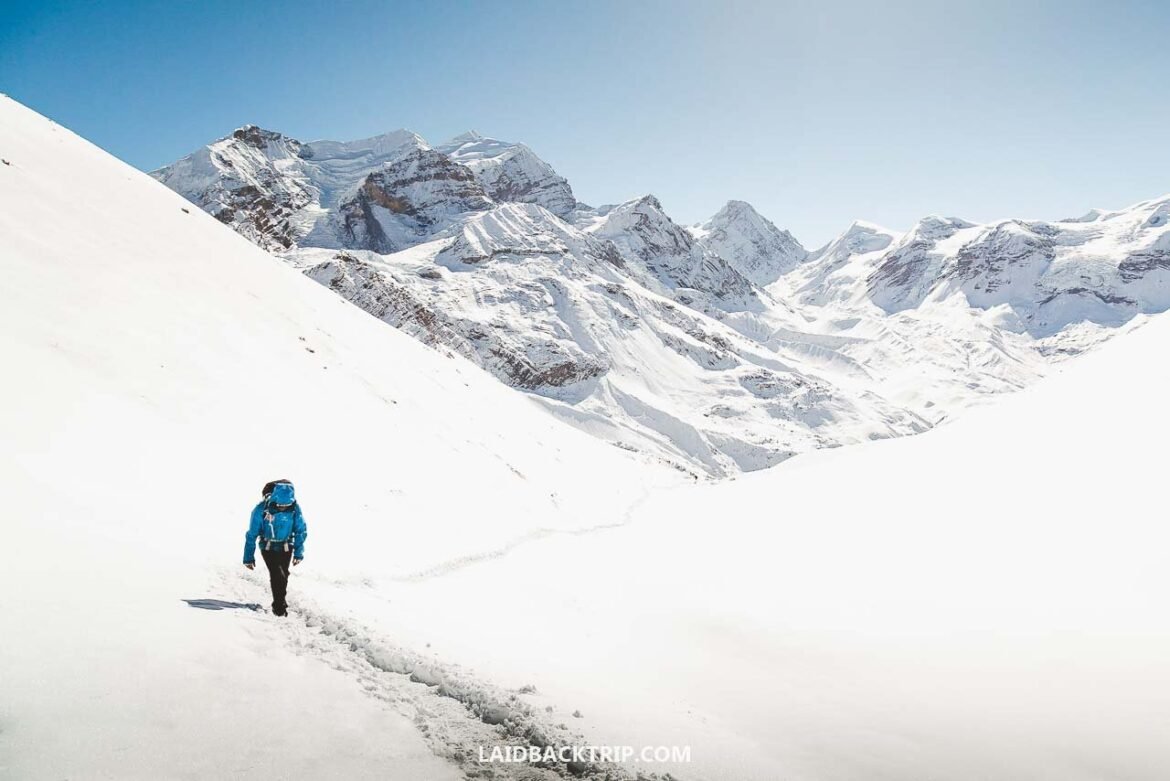A challenging yet magnificent entry point to some of the most amazing hiking experiences in the Himalayas is the Annapurna Circuit With Thorong La Pass. This high mountain pass, which rises to a height of 5,416 meters (17,769 feet) and crosses a tough terrain between the districts of Manang and Mustang, provides adventurous hikers with an amazing experience of trekking across Nepal’s breathtaking scenery. Situated strategically along this circuit, Thorong La Pass links the districts of Manang and Mustang. It is also among the world’s highest passes.
One of the most popular trekking routes in the world, the Annapurna Circuit, passes via the Thorong La Pass, which puts hikers to the test of their fortitude and resiliency. Trekkers experience both difficulty and reward on the ascent to the pass, with each step bringing them closer to the breathtaking views they will find at the top.
Trekkers are welcomed by a breathtaking vista of glaciers and snow-capped peaks as far as the eye can reach as they approach the pass. Trekkers are in awe of the untainted beauty and raw strength of nature as the Annapurna Massif, with its imposing peaks like Dhaulagiri (8,167 meters) and Annapurna I (8,091 meters), dominates the skyline.
Even the most experienced hikers are challenged by the severe weather and thin air when crossing the Thorong La Pass, which calls for both mental and physical toughness. But every step is worthwhile because of the amazing views from the summit and the sense of accomplishment you get from reaching the top. Actually, before traveling over the Thorong La Pass and into Mustang, hikers are advised to stay five nights in Manang by the Himalayan Rescue Association.
For convenience and safety, Thorong La Pass is always traversed from east to west. The majority of individuals who intend to traverse Thorong La Pass spend the night at either Thorong High Camp (4,880 meters / 16,010 feet) or Thorong Phedi (4,540 meters / 14,895 feet). Trekkers rise as early as three in the morning at Thorong Phedi, battle the bitter cold winds and difficult terrain, pass the Thorong La Pass before daybreak, and arrive to Muktinath in time to dodge the afternoon breeze.
It is not advisable to attempt crossing Thorong La Pass from the east to the west due to the sudden and significant height gain, which does not provide sufficient time for acclimatization. The brave ones that accept this adventure stay at Ranipauwa, which is 3,670 meters (12,041 feet) high.
The magnificent Himalayas reaching to Tibet can be seen from the Thorong La Pass with Annapurna Circuit, and if you turn around, you can also see the breathtaking Annapurna range.
March, April, October, and November are the months that are the safest to traverse the Thorong La Pass. There is a higher chance of frostbite, avalanches, and storm whiteouts in other months.
You will enter the Mustang region—a land of bleak beauty and ancient Tibetan influences—after passing over this pass. The trail meanders through parched terrain peppered with historic monasteries and communities that appear to have stood the test of time, providing a window into a way of life that hasn’t altered in many years. The majority of hikers arrive at Muktinath Temple and traverse Throng La Pass in one day.
Muktinath Temple holds great significance for both Buddhists and Hindus. This shrine is attributed to Lord Vishnu by Hindus. With water coming from the Kali Gandaki River, it is well known for its 108 water sprouts. Nonetheless, documents show that Muktinath was a temple dedicated to the Buddhist deity Avalokiteshvara until the middle of the eighteenth century. This shrine is known as Chumming Gyatsa, or “Hundred waters,” by the Buddhists. Before traveling to Tibet, the Tibetans believe that Guru Rinpoche, also known as Padmasambhava, meditated at Muktinath. Tibetan Buddhism is said to have been founded by Guru Rinpoche.
Either way, the Thorong La Pass and the Annapurna Circuit offer an absolutely amazing experience for those who are adventure-seekers willing to push their limits or seasoned trekkers seeking a new challenge. This walk is evidence of the lasting appeal of Nepal’s Himalayan beauties, from the breathtaking views and rough terrain to the rich cultural tapestry woven into the adventure.




